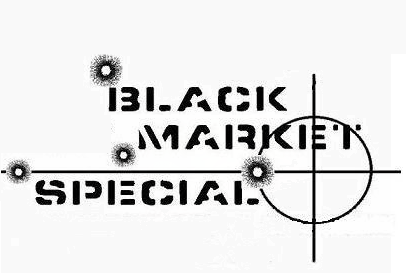
Since this is my first article, and one of the first in the “Black Market” series, I’ve got initiative on my mind. Tracking initiative has been a staple of just about every RPG I’ve ever played. Games have a variety of ways to determine who goes first, and in which order. As a GM, I’ve used a variety of methods over the years to help me, and my PCs, keep track of who’s turn it is and who’s up next.
The first, and most tried and true method is quite simply writing it down on a piece of notebook paper. Usually used for all my early days in D&D and the Star Wars RPG, it worked fine as long as someone didn’t do anything that delayed their action or caused their place in initiative to change. It also made things difficult for when I had new additions to the battle. Usually I just resolved to move them to the end of the order. Erasing an entire line and moving a person become problematic, at best.
Sometime in college, I started to utilize dry erase boards as my preferred medium for not only quickly drawing out position in combat, but also for initiative. With a swipe of the finger, I can erase names and quickly re-order them. This is one method I still use today. You can generally find a decent, inexpensive dry erase board the size of a clip board or standard sheet of paper for about $5-$10. Try to get a magnetic one, if you can (I’ll show you why in a minute). Next, get 2 different colors of markers. Your standard 4-pack comes with black, green, red, and blue. Perfect assortment for your needs. When it’s time to roll initiative, go around and write down the order however the system determines it. For D&D, start at the highest initiative slot and work your way down to the lowest. For the FFG Star Wars RPG, you just write in “PC” or “NPC”, since their initiative order is more fluid. Whoever’s turn it is, use the black (or green) marker and put a little hatch-mark next to it. Or, if you’ve got a magnetic board, use a magnet and slide it up and down to whoever’s turn it is now.

During my days running D&D 3.5 and Star Wars Saga Edition I started to use a stack of initiative cards. These little cards are half the size of your standard 3”x5” index card. I used to buy them and cut them down the middle until I found a store that carried a stack of 200 of them already 2.5”x3”. Every PC had a card, and I’d write the specific NPC (or NPC group) down on their own card and everyone rolled initiative. I’d organize the cards in the order of highest to lowest initiative and then just cycle through the deck. When someone did anything like a held action, or delayed action, I’d take their card out of the stack and hold it to the side. When that character finally acted, I put their card back on the bottom of the deck. With forethought, I would even write down important details for the PCs (like Defense/AC numbers) so I wasn’t constantly asking the player what I needed to hit them. (Note – This only worked so far as the PC wasn’t doing anything to change their defense number.)
These days, I’ve started using a new product from Alea Tools. I’ve used their magnetic counters in the past to help denote a variety of states and effects, but when matched with a magnetic board it helps me with my initiative order. They recently completed a Kickstarter where they produced these new Initiative Boards. It’s a magnetic plate with a broad line down the middle. You place your magnetic markers on the board in the order of initiative. Since their markers are plastic, dry erase pens can be used on them with little to no staining. You write down the PC’s or NPC’s name on a marker and stick it to the board on the line. Another arrow marker slides along the top of the board to show who’s turn it is. You can even slide a token down below the line if the character is holding thier action, and then if they take their action before their turn comes around again you can quickly move tokens around and re-order them. It’s even easier for playing FFG’s Star Wars RPG, where I just grab a blue colored Alea Tools marker for PCs, and red ones for NPCs. Determine the order and place the appropriate colored token on the initiative board.
This is all well and good for the initiative board, but what if you didn’t get in on their Kickstarter, and they never make these boards for the general public (which would be a shame)? You can do the same thing pretty much with that normal magnetic dry-erase board and a stack of their tokens. The magnets work on either board just as well, and it probably ends up being cheaper in the long run.

Tracking initiative can be a tricky, time consuming process that takes away from the flow of the game and slows down the enjoyment for all involved. Take some time and find a method that works best for you, and you’ll find those initiative rolls become less of a chore.
May the dice be with you.

I use my old Pathfinder dry erase Initiative tracker board to the same effect. It also makes it easy to track thresholds/make notes/etc.